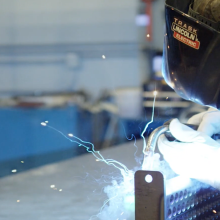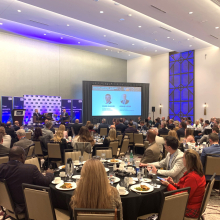COVID-19 Prevention Best Practices
Return to work safely
Throughout the challenges presented by the COVID-19 public health emergency, the Minnesota Chamber’s goal has been to strike a balance between safeguarding health and protecting Minnesota’s economy. Minnesota businesses are eager to get back to work. Business operations can and should return to a sustainable level without jeopardizing employees’ or customer safety.
Based on the best practices shared by employers in these critical industries, the Minnesota Chamber of Commerce provides the following guidelines and suggestions to assist other Minnesota businesses in their efforts to provide safe workplaces for their employees and customers as they come back online.
Businesses are eager to have access to testing that will help identify individuals who may be sick with the virus and those who may be immune. Acceleration of testing availability is critically important to restoring public confidence and reopening our economy. By implementing these best practices, businesses are still subject to the restrictions of current or future executive orders.
The starting place for all industries is the comprehensive federal guidance provided by the Department of Labor’s Occupational Safety and Health Administration (OSHA) and the Centers for Disease Control and Prevention (CDC).

https://www.osha.gov/Publications/OSHA3990.pdf

https://www.cdc.gov/coronavirus/2019-ncov/community/guidance-business-response.html
The following suggested guidelines can be replicated as general best practices, applicable to most workplaces. Download the PDF here. Also, the Grow Minnesota! Partnership team developed a checklist based on feedback from hundreds of companies who have developed or executed “return to work” plans for their business. Click here to download.
Personal protection and facilities cleaning, sanitizing
- Create training to review new safe-at-work requirements and guidelines for all employees.
- If returning to work, training and orientations should be done on day one.
- Make information available to employees about Personal Protective Equipment, disinfection measures, social distancing protocol, on-site health screening, signs and symptoms of COVID-19, self-quarantining and return-to-work policies, visitors and contractors screening, signage, time-off options and all other COVID-19-related safe workplace changes.
- Train employees on frequent hand washing; properly covering coughs and sneezes; refraining from touching the face.
- Clean and sanitize surfaces frequently.
- Make wipes, sanitizer and cleaning products widely accessible throughout workplaces.
- Clean the break rooms and common touch areas (doorknobs, etc.) after each shift.
- Thorough cleaning of ALL shared surfaces throughout the facility at least once every 24 hours. This includes common spaces like bathrooms, conference rooms, lunchrooms, etc.
- Shut down production in the area where a COVID-19 affected employee worked (i.e. department, line, station) to conduct cleaning, as well as shut down and clean common spaces like bathrooms, conference rooms and lunchrooms once notification of potential COVID-19 spread is suspected.
- Provide masks, shields, gloves, shoe coverings, coveralls, etc. if appropriate and available.
- Provide touch-free solutions
- Touch-free time clocks.
- Individual water containers for workers instead of large water coolers.
Social distancing
- Offer work-from-home options for all employees who can perform duties remotely.
- Change shifts.
- Stagger shifts and start times to maximize distancing.
- Allow 30-minute buffers between shifts if possible so that employees don’t come into contact during transition.
- Cross-train teams, so that teams can better stagger shifts.
- Provide visual markers on floors for six-foot distancing, per CDC guidance.
- Stagger breaks and lunch schedules.
- Offer lunch breaks in vehicles instead of shared cafeterias or break rooms.
- Employees need to bring their own meals and be able to eat them without use of microwave.
- Restrict movement between departments and/or functions (e.g. don’t allow traffic between production and office workspaces).
- Conduct phone/email/virtual meetings instead of in-person meetings, even when at office.
- Limit meetings to no more than 10 individuals, provided appropriate spacing is possible.
- Hold meetings in large spaces where people can spread out at six-foot intervals.
- Space out desks and work stations; construct temporary walls between workstations.
Vendor engagement
- Request health and travel assessments for vendors/contractors coming on-site.
- Separate contractors and vendors from the workforce (have them use separate bathrooms, entrances if possible).
- Prohibit nonessential vendors and deliveries from entering facility.
- Require deliveries to be dropped outside facility door, eliminating vendors from entering facility.
Customer engagement
- Offer curbside delivery instead of in-store pick-up.
- Provide on-site services to customer’s facility once their business is closed (after hours).
- Offer drive-through service only.
- Add plastic barriers/shields at registers.
- Ask customers to stay in their vehicles in parking lot while they wait.
- Offer call-ahead services for parts and service and lock door to walk-in customers.
- Conduct virtual sales calls.
- Limit the number of customers in the facility to ensure appropriate distancing, along with visual markers on floors for six-foot distancing, per CDC guidance.
Travel policies
- Require a two-week quarantine for employees who return from outside of the country or a domestic COVID-19 hotspot.
- Require a two-week quarantine for employees traveling more than 100 miles from facility.
Monitoring employee health
- Conduct temperature or employee wellness checks at the start of shifts to ensure employee does not exhibit COVID-19 symptoms (fever >100.4 F, cough, shortness of breath/difficulty breathing).
- Create a master schedule for all employees that shows when people may come in contact with others; use this for contact tracing in the event of a confirmed or suspected COVID-19 exposure.
- Create a response plan for employees who report or demonstrate symptoms at work; have recently been at work and tested positive or have been in contact with confirmed COVID-19 case; or have not recently been at work but have tested positive or have been in contact with confirmed COVID-19 case.
- Ask employees about their health status before they return to work from a sick leave (even if they were out with a headache), require certification by a health care professional of ability to safely return to work (particularly for those noted above).
- Offer a variety of leave options for employees who may have to miss work because of a COVID-19-related reason.
Employee and customer communications / instruction / signage
- Post internal signage that can be used to alert or remind employees about guidelines and expectations and responsibilities. Post external signs on doors alerting visitors to restrictions on entry and movement in and around facility as well as any applicable guidelines and expectations.
Communications / Education / Responsibilities
- Communicate and educate employees and management to carry out the plan and protocols, as well as clear direction on roles and responsibilities. For example:
- Provide internal signage to alert co-workers to use another means to contact the person (phone, email, text).
- Post signs on door to instruct customers/visitors on business’s safety protocols.
- Provide remote workers with a list of free resources to stay healthy and active at home (i.e. ergonomic tips, stress-relief tools, fitness resources).
- Provide pre-recorded safety training videos for customer-facing activities.
- Maintain an up-to-date repository on the company’s shared network that allows employees to access all COVID-19 documents, resources, and company protocol.
COVID-19 Questions?
The Minnesota Chamber is here to help
Our COVID-19 Business Toolkit is updated daily and includes resources to help your business through this crisis. For individual business assistance, email mail@mnchamber.com.
Suggested resources
Below are trusted, industry-specific resources that may help your business when returning to work.
- Minnesota Retailers Association best practices
- Best practices for grocery store employees
- COVID‐19 Health and Safety Guidelines for the meatpacking industry from the Minnesota Department of Labor and Industry
- Public Health Principles for a Phased Reopening During COVID-19: Guidance for Governors from Johns Hopkins University
- Hospitality Minnesota best practices – Links to resources guiding COVID-19 hospitality business practices regarding enhanced cleaning and
sanitation, as well as the promotion of social distancing include- Resort, RV Resort and Campground Guidance from Hospitality Minnesota and the Minnesota Department of Administration
- Hospitality Minnesota letter to Governor Walz
- National Association of Manufacturers/Manufacturers Leadership Council Resources
- Visit Cook County Best Practices COVID-19 Reopening Plan
- MN Symptom Screener – A new web-based tool that allows businesses to enter non-personal health information to help make a determination about someone entering their facility
- Target making no-touch infrared forehead thermometers available to Minnesota businesses at cost
- National Restaurant Association reopening guidance
- 5 Employer Considerations to Return to Worksite from UnitedHealthcare
- State-by-State Business Reopening Guidance from the U.S. Chamber of Commerce
- Considerations for Retail Operations Post COVID-19 from Target
- ASHRAE and CDC Reopening Guidelines from 75F
- Minnesota Chamber of Commerce return to work checklist
- Ready to Reopen: A Playbook for Your Small Business from the U.S. Chamber of Commerce
- Open for Business poster PDF from the Minnesota Chamber of Commerce
- A State-by-state Guide to What's Open and How to Travel Safely in the U.S.
- Multilingual Video Resources For Re-opening Restaurants from the Southwest Initiative Foundation
- COVID-19 Preparedness Plan templates and instructions from Minnesota Department of Labor and Industry
- Explore Minnesota COVID-19 Toolkit for the Minnesota tourism industry
- "Please keep 6 feet apart" workplace floor sticker
- Please wear a mask to help Minnesotans and businesses - A letter to the editor from Rep. Dave Baker and Sen. Andrew Lang
- COVID-19 Recommendations for Critical Infrastructure Businesses and Industries from the Minnesota Department of Health


